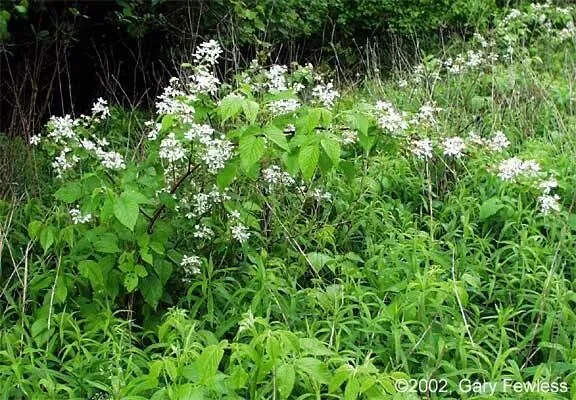
Author: Porter
Bibliography: Bull. Torrey Bot. Club 23: 153 (1896)
Year: 1896
Status: accepted
Rank: species
Genus: Rubus
Vegetable: False
Observations: E. Canada to NC. & E. U.S.A.
The Sow-teat blackberry, scientifically known as Rubus allegheniensis, is a noteworthy member of the Rosaceae family. This plant was formally documented in 1896 by Porter, with his findings published in the Bulletin of the Torrey Botanical Club.
Rubus allegheniensis is recognized for its distinctive appearance and ecological importance. It thrives predominantly in the regions stretching from Eastern Canada to North Carolina and is widely observed across the Eastern United States. This perennial plant typically flourishes in a variety of habitats, including woodlands, fields, and disturbed areas, showcasing its adaptability and resilience.
The Sow-teat blackberry is characterized by its robust canes, which are often armed with formidable thorns. During its blooming period, it displays clusters of delicate white flowers that eventually give way to luscious blackberry fruit. These fruits are not only an essential food source for wildlife but have also been traditionally harvested by humans for various culinary uses.
Understanding the distribution and characteristics of Rubus allegheniensis is vital for those interested in botany, ecology, and conservation. Its presence supports local ecosystems by providing habitat and food for numerous animal species, thus underscoring its ecological significance.
Eng: allegheny blackberry, sow-teat blackberry, highbush blackberry, common blackberry
Deu: allegheny-brombeere, alleghenybrombeere
Dan: allegheny-brombær
Pol: jeżyna alegańska
Nob: alleghenybjørnebær
Nno: alleghenybjørnebær
Swe: mustavatukka, sammetsbjörnbär
Fin: mustavatukka
Ces: ostružník alleghenský
Nld: kleine trosbraam
Fra: ronce des alléghanys, mûrier, ronce alléghanienne
En: Sow-teat blackberry, Allegheny blackberry, Highbush Blackberry, Common blackberry
Cs: Ostružiník alleghenský, Ostružník alleghenský
Da: Allegheny-brombær
Nl: Kleine trosbraam
Fi: Mustavatukka
Fr: Ronce des Alléghanys, Mûrier, Ronce alléghanienne
De: Alleghenybrombeere, Allegheny-Brombeere
Nb: Alleghenybjørnebær
Nn: Alleghenybjørnebær
Pl: Jeżyna alegańska
Sv: Sammetsbjörnbär, Mustavatukka
© copyright of the Board of Trustees of the Royal Botanic Gardens, Kew.
© copyright of the Board of Trustees of the Royal Botanic Gardens, Kew.
© copyright of the Board of Trustees of the Royal Botanic Gardens, Kew.
Taken Oct 8, 2022 by Mango Don (cc-by-sa)
Taken Oct 8, 2022 by Mango Don (cc-by-sa)
Taken Jun 3, 2011 by Mango Don (cc-by-sa)
Taken Jun 3, 2011 by Mango Don (cc-by-sa)
Taken Oct 8, 2022 by Mango Don (cc-by-sa)
Taken Oct 8, 2022 by Mango Don (cc-by-sa)
Taken Oct 8, 2022 by Mango Don (cc-by-sa)
Taken Sep 26, 2022 by Mango Don (cc-by-sa)
Taken Oct 27, 2012 by Mango Don (cc-by-sa)
Taken Oct 27, 2012 by Mango Don (cc-by-sa)
Taken Oct 8, 2022 by Mango Don (cc-by-sa)
Taken Oct 27, 2012 by Mango Don (cc-by-sa)
Taken Oct 27, 2012 by Mango Don (cc-by-sa)
Taken Sep 26, 2022 by Mango Don (cc-by-sa)
Taken Oct 8, 2022 by Mango Don (cc-by-sa)
Taken Oct 8, 2022 by Mango Don (cc-by-sa)
Taken Oct 8, 2022 by Mango Don (cc-by-sa)
Taken Oct 8, 2022 by Mango Don (cc-by-sa)
Taken Oct 8, 2022 by Mango Don (cc-by-sa)
Taken Oct 8, 2022 by Mango Don (cc-by-sa)
Taken May 22, 2015 by Mango Don (cc-by-sa)
Taken Jun 16, 2021 by Brett Bockhop (cc-by-sa)
Taken May 22, 2019 by Mango Don (cc-by-sa)
Taken Oct 8, 2022 by Mango Don (cc-by-sa)
Taken Oct 8, 2022 by Mango Don (cc-by-sa)
Growth form: Thicket Forming
Growth habit: Subshrub
Growth rate: Rapid
Ph maximum: 7.5
Ph minimum: 4.6
Light: 6
Atmospheric humidity: 6
Soil nutriments: 5
Family: Myrtaceae Author: (F.Muell.) K.D.Hill & L.A.S.Johnson Bibliography: Telopea 6: 402 (1995) Year: 1995 Status:…
Family: Rubiaceae Author: Pierre ex A.Froehner Bibliography: Notizbl. Bot. Gart. Berlin-Dahlem 1: 237 (1897) Year:…
Family: Sapindaceae Author: Koidz. Bibliography: J. Coll. Sci. Imp. Univ. Tokyo 32(1): 38 (1911) Year:…
Family: Asteraceae Author: A.Gray Bibliography: Pacif. Railr. Rep.: 107 (1857) Year: 1857 Status: accepted Rank:…
Family: Fabaceae Author: Medik. Bibliography: Vorles. Churpfälz. Phys.-Ökon. Ges. 2: 398 (1787) Year: 1787 Status:…
Family: Aspleniaceae Author: (Cav.) Alston Bibliography: Bull. Misc. Inform. Kew 1932: 309 (1932) Year: 1932…